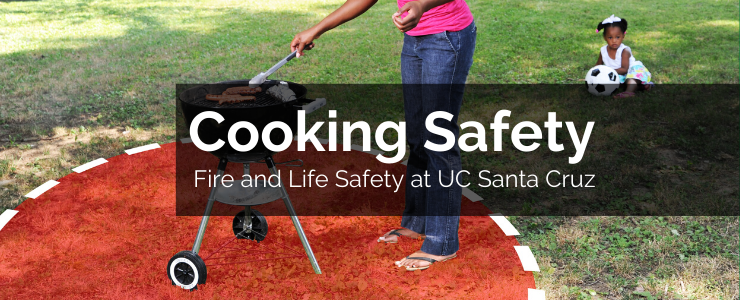Cooking Safety
Upon arriving at UC Santa Cruz, many members of our community decide to cook their own food for some or all of their meals. UCSC Housing offers housing configurations that include ovens, stovetops, and microwaves that can be used by members of our community for cooking purposes. Whether you are a veteran chef or a newcomer to the culinary arts, there are several steps you should take to ensure the safety of yourself and your peers when cooking.
Before you cook:
- Make sure that you are physically awake and aren't at risk of falling asleep while cooking.
- Clear the cooking/preparation area of anything that can burn (paper, fabrics, cardboard, etc.)
- Ensure that any children or pets are no less than three feet away from the stove/oven.
- Try to wear short or close-fitting sleeves that are at low risk of snagging or getting burnt.
- Check the cleanliness of your cleaning surfaces to ensure that there is no food or grease build-up.
While cooking:
- Keep an eye on your cooking and stay in the kitchen! Unattended cooking is the #1 cause of cooking-related fires.
- Turn pot handles toward the back of the stove (away from you) so that no one can bump into them or pull them over.
- Keep a pan lid or baking sheet nearby so that you can 'suffocate' any small fires that occur by covering the cooking surface.
- In any case where you are unsure if you can properly smother a cooking-related fire, alert all residents of your home and get out closing the door behind you. Then, call 9-1-1.
- Use oven mitts to move hot pots, pans, and baking sheets to avoid burns and spills.
More Information
FEMA Prevent Kitchen Fires (PDF)
Grilling Safety
Grilling is an immensely popular way to cook food, especially during the Summer period. While UCSC Housing expressly prohibits the use of grilling on campus for individual use, campus organizations can seek approval from the UCSC Designated Campus Fire Marshal to perform outdoor grilling. At the same time, individuals living in non-UCSC housing may be interested in grilling.
While grilling is an effective and tasty way to cook food, it poses risks to personal health and safety. The following guidelines are provided as a means to reduce the risk of harm for the cooks and community members.
- Only use propane and charcoal grills outdoors.
- Ensure that grills are away from the home, under eaves, or overhanging branches.
- Keep children and pets no less than three feet away from the grilling area.
- Check your grill (and the catching trays) for a build-up of grease or fat prior to use.
- Never leave your grill unattended.
More Information
FEMA Grilling Fire Safety (PDF)
Scalding Safety
Being a college student is often synonymous with surviving off of a preferred brand of low-cost noodle soup. This soup, heated through the boiling of a pot of water or adding water and using a microwave, is the essence of 3AM study (or procrastination) sessions. A scalding burn is a type of thermal burn that is caused by exposure to hot water or steam. As the second leading cause of all burns, it is important that you understand both how to avoid them and how to immediately treat them.
A few common strategies for avoiding scald burns include:
- Testing faucet water by moving your hand, wrist, and forearm through the water quickly to check if the water is too hot.
- Placing hot liquids and food towards the center of a table or further back on a counter.
- Open microwaved food slowly, away from the face.
- Allow microwaved food to cool before eating.
- Select prepackaged foods whose containers have a wide base to allow for faster heat distribution.
- Pour microwaved or heated soups into a traditional bowl after heating.
If you get burned:
- Get away from the heat source as soon as possible.
- Treat it immediately by cooling the burn with cool (not cold) water for up to 20 minutes.
- Remove any clothing or jewellery that is near the burned area of skin.
- Cover the burned area with a clean, dry cloth.
More Information

